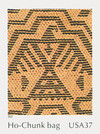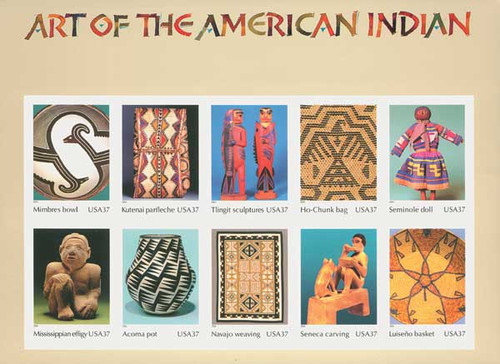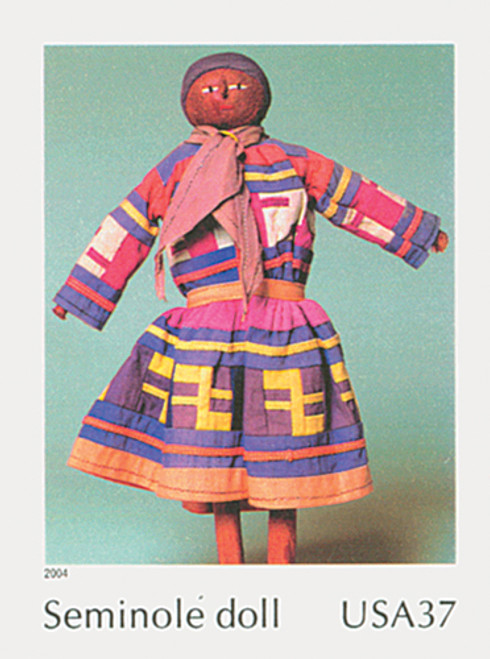
2004 37c Art of the American Indian: Ho-Chunk Bag
# 3873d - 2004 37c Art of the American Indian: Ho-Chunk Bag
$2.25 - $3.75
U.S. #3873d
2004 37¢ Art of American Indian
2004 37¢ Art of American Indian
Issue Date: August 21, 2004
City: Santa Fe, NM
Quantity: 8,700,000
City: Santa Fe, NM
Quantity: 8,700,000
Printed By: Avery Dennison
Printing Method: Photogravure
Perforations: 10 ¾ x 11
Color: Multicolored
These stamps provide examples of the artistic talent that American Indians from all parts of the country applied to everyday and ceremonial objects. Native craftspeople used the natural resources of each area – plant and animal fibers, clay, stone, and wood – to create distinctive and enduring designs.
The California and Intermountain Indians made beautiful, finely woven baskets that they used for the gathering, storing, and cooking of food.
The Iroquois used containers made of bark, and they carved bowls, ladles, and other utensils from wood. In their hands, common wooden utensils became works of art.
Mississippian craftsmen achieved remarkable results with natural materials. Stone and clay objects were often shaped in the form of effigies (images of people or animals).
To carry and store their belongings, Plains Indian women fashioned cases from raw animal hide. These folded or sewn rawhide envelopes, “parfleches,” were light, rigid, and strong, colorfully painted in geometric patterns.
Skilled Tlingit carvers cut natural and symbolic faces and figures into canoe prows, totem poles, door posts, food utensils, storage and cooking boxes, ceremonial masks, and screen partitions. Large totem poles, carved from cedar trunks, stood in front of homes and told the story of the mother’s clan, or a legend or event.
Florida Seminole women decorated their garments with sewn-on bands of cloth. When white traders introduced hand-operated sewing machines, more intricate patterns became possible. Dolls dressed in traditional Seminole “patchwork” clothes were sold to tourists.
Skilled Navajo craftworkers are famous for their beautiful turquoise and silver jewelry and their finely woven blankets and rugs.
The Mimbres of the Classic period made strikingly beautiful, black-on-white pottery, painted with humans, animals, mythic creatures, and bold, geometric patterns.
Winnebago women wove, twined, and braided a variety of natural materials into bags, sashes, and mats. Combining twisting and weaving techniques, Winnebago women made bags to carry and store sacred charms and household goods.
The Acoma Pueblo in New Mexico is known for strong, thin-walled pottery decorated with geometric designs.
U.S. #3873d
2004 37¢ Art of American Indian
2004 37¢ Art of American Indian
Issue Date: August 21, 2004
City: Santa Fe, NM
Quantity: 8,700,000
City: Santa Fe, NM
Quantity: 8,700,000
Printed By: Avery Dennison
Printing Method: Photogravure
Perforations: 10 ¾ x 11
Color: Multicolored
These stamps provide examples of the artistic talent that American Indians from all parts of the country applied to everyday and ceremonial objects. Native craftspeople used the natural resources of each area – plant and animal fibers, clay, stone, and wood – to create distinctive and enduring designs.
The California and Intermountain Indians made beautiful, finely woven baskets that they used for the gathering, storing, and cooking of food.
The Iroquois used containers made of bark, and they carved bowls, ladles, and other utensils from wood. In their hands, common wooden utensils became works of art.
Mississippian craftsmen achieved remarkable results with natural materials. Stone and clay objects were often shaped in the form of effigies (images of people or animals).
To carry and store their belongings, Plains Indian women fashioned cases from raw animal hide. These folded or sewn rawhide envelopes, “parfleches,” were light, rigid, and strong, colorfully painted in geometric patterns.
Skilled Tlingit carvers cut natural and symbolic faces and figures into canoe prows, totem poles, door posts, food utensils, storage and cooking boxes, ceremonial masks, and screen partitions. Large totem poles, carved from cedar trunks, stood in front of homes and told the story of the mother’s clan, or a legend or event.
Florida Seminole women decorated their garments with sewn-on bands of cloth. When white traders introduced hand-operated sewing machines, more intricate patterns became possible. Dolls dressed in traditional Seminole “patchwork” clothes were sold to tourists.
Skilled Navajo craftworkers are famous for their beautiful turquoise and silver jewelry and their finely woven blankets and rugs.
The Mimbres of the Classic period made strikingly beautiful, black-on-white pottery, painted with humans, animals, mythic creatures, and bold, geometric patterns.
Winnebago women wove, twined, and braided a variety of natural materials into bags, sashes, and mats. Combining twisting and weaving techniques, Winnebago women made bags to carry and store sacred charms and household goods.
The Acoma Pueblo in New Mexico is known for strong, thin-walled pottery decorated with geometric designs.














